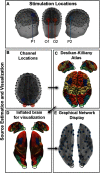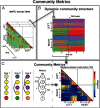Reconfigurations within resonating communities of brain regions following TMS reveal different scales of processing
- PMID: 32885118
- PMCID: PMC7462427
- DOI: 10.1162/netn_a_00139
Reconfigurations within resonating communities of brain regions following TMS reveal different scales of processing
Abstract
An overarching goal of neuroscience research is to understand how heterogeneous neuronal ensembles cohere into networks of coordinated activity to support cognition. To investigate how local activity harmonizes with global signals, we measured electroencephalography (EEG) while single pulses of transcranial magnetic stimulation (TMS) perturbed occipital and parietal cortices. We estimate the rapid network reconfigurations in dynamic network communities within specific frequency bands of the EEG, and characterize two distinct features of network reconfiguration, flexibility and allegiance, among spatially distributed neural sources following TMS. Using distance from the stimulation site to infer local and global effects, we find that alpha activity (8-12 Hz) reflects concurrent local and global effects on network dynamics. Pairwise allegiance of brain regions to communities on average increased near the stimulation site, whereas TMS-induced changes to flexibility were generally invariant to distance and stimulation site. In contrast, communities within the beta (13-20 Hz) band demonstrated a high level of spatial specificity, particularly within a cluster comprising paracentral areas. Together, these results suggest that focal magnetic neurostimulation to distinct cortical sites can help identify both local and global effects on brain network dynamics, and highlight fundamental differences in the manifestation of network reconfigurations within alpha and beta frequency bands.
Keywords: EEG; Local-global processing; Network allegiance; Network flexibility; Neuroimaging; TMS.
No rights reserved. This work was authored as part of the Contributors official duties as an Employee of the United States Government and is therefore the work of the United States Government. In accordance with 17 U.S.C. 105, no copyright protection is available for such works under U.S. law.
Figures







Similar articles
-
Distinct Oscillatory Frequencies Underlie Excitability of Human Occipital and Parietal Cortex.J Neurosci. 2017 Mar 15;37(11):2824-2833. doi: 10.1523/JNEUROSCI.3413-16.2017. Epub 2017 Feb 8. J Neurosci. 2017. PMID: 28179556 Free PMC article.
-
Top-down interference and cortical responsiveness in face processing: a TMS-EEG study.Neuroimage. 2013 Aug 1;76:24-32. doi: 10.1016/j.neuroimage.2013.03.020. Epub 2013 Mar 21. Neuroimage. 2013. PMID: 23523809
-
Can Oscillatory Alpha-Gamma Phase-Amplitude Coupling be Used to Understand and Enhance TMS Effects?Front Hum Neurosci. 2019 Jul 31;13:263. doi: 10.3389/fnhum.2019.00263. eCollection 2019. Front Hum Neurosci. 2019. PMID: 31427937 Free PMC article.
-
Multimodal transcranial magnetic stimulation: using concurrent neuroimaging to reveal the neural network dynamics of noninvasive brain stimulation.Prog Neurobiol. 2011 Jul;94(2):149-65. doi: 10.1016/j.pneurobio.2011.04.004. Epub 2011 Apr 16. Prog Neurobiol. 2011. PMID: 21527312 Review.
-
Measuring Brain Stimulation Induced Changes in Cortical Properties Using TMS-EEG.Brain Stimul. 2015 Nov-Dec;8(6):1010-20. doi: 10.1016/j.brs.2015.07.029. Epub 2015 Jul 17. Brain Stimul. 2015. PMID: 26275346 Review.
Cited by
-
A Dynamical Systems Approach to Characterizing Brain-Body Interactions during Movement: Challenges, Interpretations, and Recommendations.Sensors (Basel). 2023 Jul 11;23(14):6296. doi: 10.3390/s23146296. Sensors (Basel). 2023. PMID: 37514591 Free PMC article. Review.
-
Understanding diaschisis models of attention dysfunction with rTMS.Sci Rep. 2020 Sep 10;10(1):14890. doi: 10.1038/s41598-020-71692-6. Sci Rep. 2020. PMID: 32913263 Free PMC article.
References
LinkOut - more resources
Full Text Sources
Other Literature Sources
